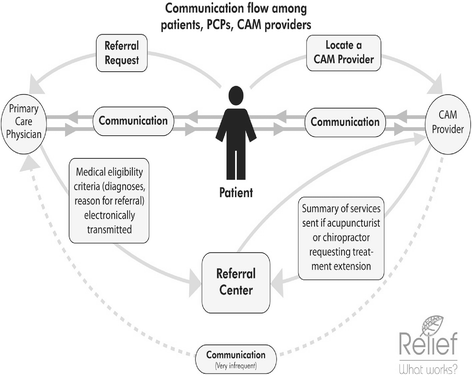Primary care physicians, acupuncture and chiropractic clinicians, and chronic pain patients: a qualitative analysis of communication and care coordination patterns
- PMID: 26810302
- PMCID: PMC4727288
- DOI: 10.1186/s12906-016-1005-4
Primary care physicians, acupuncture and chiropractic clinicians, and chronic pain patients: a qualitative analysis of communication and care coordination patterns
Abstract
Background: A variety of people, with multiple perspectives, make up the system comprising chronic musculoskeletal pain (CMP) treatment. While there are frequently problems in communication and coordination of care within conventional health systems, more opportunities for communicative disruptions seem possible when providers use different explanatory models and are not within the same health management system. We sought to describe the communication system surrounding the management of chronic pain from the perspectives of allopathic providers, acupuncture and chiropractor (A/C) providers, and CMP patients.
Methods: We collected qualitative data from CMP patients (n = 90) and primary care physicians (PCPs) (n = 25) in a managed care system, and community acupuncture and chiropractic care providers (n = 14) who received high levels of referrals from the system, in the context of a longitudinal study of CMP patients' experience.
Results: Multiple points of divergence and communicative barriers were identified among the main stakeholders in the system. Those that were most frequently mentioned included issues surrounding the referral process (requesting, approving) and lack of consistent information flow back to providers that impairs overall management of patient care. We found that because of these problems, CMP patients were frequently tasked and sometimes overwhelmed with integrating and coordinating their own care, with little help from the system.
Conclusions: Patients, PCPs, and A/C providers desire more communication; thus systems need to be created to facilitate more open communication which could positively benefit patient outcomes.
Figures

Similar articles
-
Provider and patient perspectives on opioids and alternative treatments for managing chronic pain: a qualitative study.BMC Fam Pract. 2017 Mar 24;17(1):164. doi: 10.1186/s12875-016-0566-0. BMC Fam Pract. 2017. PMID: 28403822 Free PMC article.
-
Acupuncture and chiropractic care for chronic pain in an integrated health plan: a mixed methods study.BMC Complement Altern Med. 2011 Nov 25;11:118. doi: 10.1186/1472-6882-11-118. BMC Complement Altern Med. 2011. PMID: 22118061 Free PMC article. Clinical Trial.
-
Acupuncture and chiropractic care: utilization and electronic medical record capture.Am J Manag Care. 2015 Jul 1;21(7):e414-21. Am J Manag Care. 2015. PMID: 26295269 Free PMC article.
-
A Comprehensive Review of Alternative Therapies for the Management of Chronic Pain Patients: Acupuncture, Tai Chi, Osteopathic Manipulative Medicine, and Chiropractic Care.Adv Ther. 2021 Jan;38(1):76-89. doi: 10.1007/s12325-020-01554-0. Epub 2020 Nov 12. Adv Ther. 2021. PMID: 33184777 Free PMC article. Review.
-
Chiropractic and geriatrics: a review of the training, role, and scope of chiropractic in caring for aging patients.Clin Geriatr Med. 2004 May;20(2):223-35. doi: 10.1016/j.cger.2004.02.008. Clin Geriatr Med. 2004. PMID: 15182879 Review.
Cited by
-
The Intersection of Dissemination Research and Acupuncture: Applications for Chronic Low Back Pain.Glob Adv Health Med. 2021 May 24;10:2164956120980694. doi: 10.1177/2164956120980694. eCollection 2021. Glob Adv Health Med. 2021. PMID: 34104573 Free PMC article.
-
What do patients experience? Interprofessional collaborative practice for chronic conditions in primary care: an integrative review.BMC Prim Care. 2022 Jan 14;23(1):8. doi: 10.1186/s12875-021-01595-6. BMC Prim Care. 2022. PMID: 35172731 Free PMC article. Review.
-
The primary spine practitioner as a new role in healthcare systems in North America.Chiropr Man Therap. 2022 Feb 9;30(1):6. doi: 10.1186/s12998-022-00414-8. Chiropr Man Therap. 2022. PMID: 35139859 Free PMC article.
-
A multi-level implementation strategy to increase adoption of chiropractic care for low back pain in primary care clinics: a randomized stepped-wedge pilot study protocol.Chiropr Man Therap. 2025 Feb 20;33(1):9. doi: 10.1186/s12998-024-00565-w. Chiropr Man Therap. 2025. PMID: 39979943 Free PMC article.
-
Provider and patient perspectives on opioids and alternative treatments for managing chronic pain: a qualitative study.BMC Fam Pract. 2017 Mar 24;17(1):164. doi: 10.1186/s12875-016-0566-0. BMC Fam Pract. 2017. PMID: 28403822 Free PMC article.
References
-
- Manek NJ, MacGregor AJ. Epidemiology of back disorders: prevalence, risk factors, and prognosis. Curr Opin Rheumatol. 2005;17:134–40. - PubMed
-
- Kaiser Permanente Northwest Clinical Practice Guidelines . Low back problems and lumbar radiculopathy. An Evidence-Based Clinical Practice Guideline. 2004.
Publication types
MeSH terms
Grants and funding
LinkOut - more resources
Full Text Sources
Other Literature Sources
Medical

